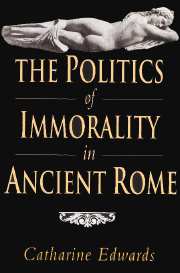Book contents
- Frontmatter
- Contents
- Preface
- Introduction
- 1 A moral revolution? The law against adultery
- 2 Mollitia: reading the body
- 3 Playing Romans: representations of actors and the theatre
- 4 Structures of immorality: rhetoric, building and social hierarchy
- 5 Prodigal Pleasures
- Bibliography
- Index locorum
- Index of subjects and proper names
2 - Mollitia: reading the body
Published online by Cambridge University Press: 23 September 2009
- Frontmatter
- Contents
- Preface
- Introduction
- 1 A moral revolution? The law against adultery
- 2 Mollitia: reading the body
- 3 Playing Romans: representations of actors and the theatre
- 4 Structures of immorality: rhetoric, building and social hierarchy
- 5 Prodigal Pleasures
- Bibliography
- Index locorum
- Index of subjects and proper names
Summary
The ancient Romans have been so domesticated that many modern western men (fewer women, perhaps) have been able to imagine themselves, their rusty Latin refreshed, easily adapting to life in the time of Cicero or the younger Pliny. But language is not the only barrier which separates us from the Romans. Entire vocabularies of gesture differ from one culture to another. For Romans, a particular physical movement could have a meaning quite at variance with one a modern Briton might attribute to it – even indicating a category of behaviour for which we have no close equivalent.
Cicero is supposed to have said of Julius Caesar:
… that a tyrannical purpose was evident in most of Caesar's political plans and projects. ‘On the other hand,’ he said, ‘when I look at his exquisitely arranged hair and see him scratching his head with one finger, I find it impossible to believe that this man would ever conceive of so great a crime as the overthrow of the Roman constitution.’
(Plut. Jul. 4.4)According to Cicero, Caesar used to scratch his head with one finger – for us a movement of little significance. But Cicero represented this as an indication that Caesar was not a man to be frightened of, that he posed no real threat. What was the connection? Scratching one's head with one finger was a sign of mollitia, which may provisionally be translated as ‘softness’ or ‘effeminacy’.
- Type
- Chapter
- Information
- The Politics of Immorality in Ancient Rome , pp. 63 - 97Publisher: Cambridge University PressPrint publication year: 1993
- 3
- Cited by

